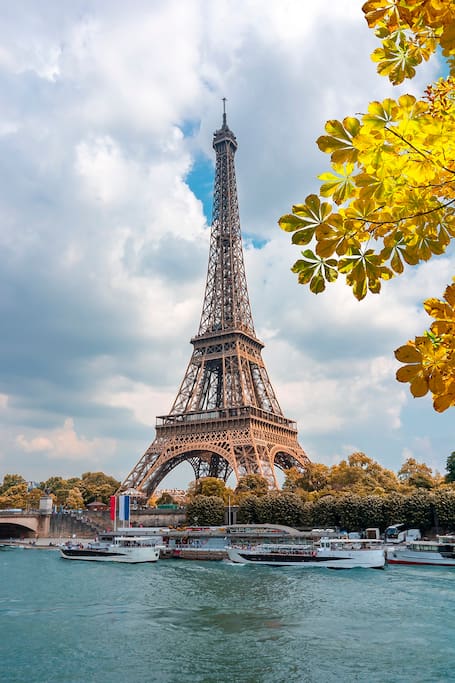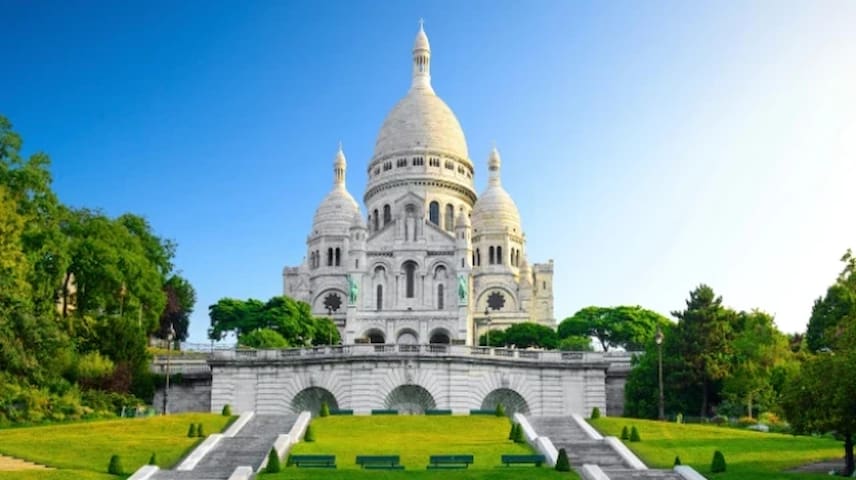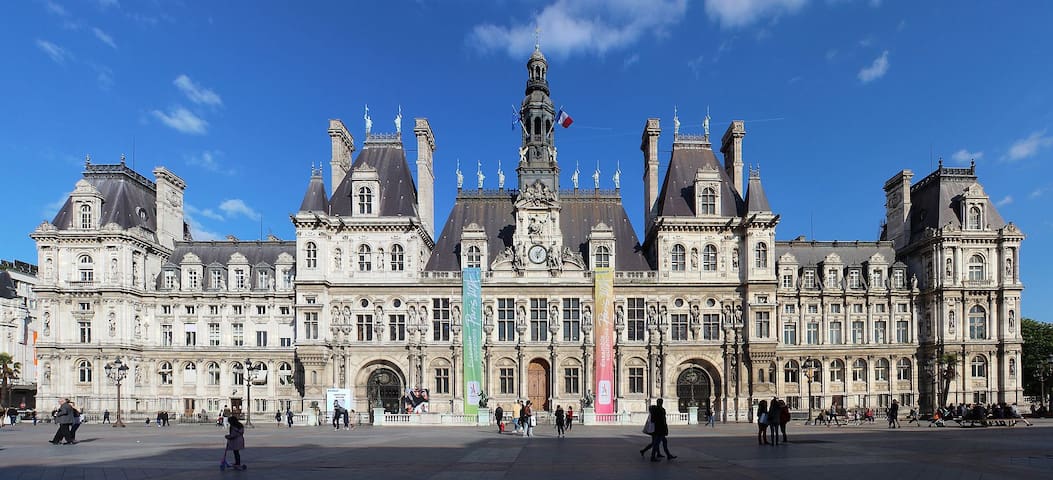Lieux emblématiques
The Eiffel Tower was built from 1887 to 1889 by French engineer Gustave Eiffel, whose company specialized in building metal frameworks and structures. Gustave Eiffel is at the origin of many metallic works in Europe including the Porto Viaduct (Portugal), the Viaduct du Garabit (France) and the Budapest train station (Hungary).
Gustave Eiffel's company, that was located in Levallois Perret, very near Paris, France, also built the metal framework for another world-famous monument: the Statue of Liberty (New York, United States), designed by Auguste Bartholdi and offered to the United States as a gift from France to celebrate the 100th anniversary of the American Declaration of Independence in 1886.
The Eiffel Tower is made of iron, not steel. The puddle iron that makes up the Eiffel Tower's structure came from the Pompey forges (East of France). The iron plates and beams produced through the puddling process were then preassembled in the Eiffel factories in Levallois Perret using rivets.
Finally, these pieces where taken to the Eiffel Tower construction site to be mounted. The prefab system is what allowed them to build the Eiffel Tower in a record time of 2 years, 2 months and 5 days.
The Eiffel Tower was built to be one the main attractions at the Paris World's Fair in 1889. That year, the World's Fair covered the entire Champ de Mars in Paris and its focus was the vast constructions in iron and steel that were the great industrial advancement of that time.
First called the 300-meter Tower, it soon took the name of the man who built it, Gustave Eiffel. The Tower opened to the public the same day as the World's Fair, on May 15, 1889.
Controversy over the Tower raged in the art world before and during its construction, but thanks to the audacity of its architecture and design, visitors and Parisians immediately fell under its charm and more than 2 million people toured it in the first year.
2943 Recomendado por los habitantes de la zona
Torre Eiffel
5 Av. Anatole FranceThe Eiffel Tower was built from 1887 to 1889 by French engineer Gustave Eiffel, whose company specialized in building metal frameworks and structures. Gustave Eiffel is at the origin of many metallic works in Europe including the Porto Viaduct (Portugal), the Viaduct du Garabit (France) and the Budapest train station (Hungary).
Gustave Eiffel's company, that was located in Levallois Perret, very near Paris, France, also built the metal framework for another world-famous monument: the Statue of Liberty (New York, United States), designed by Auguste Bartholdi and offered to the United States as a gift from France to celebrate the 100th anniversary of the American Declaration of Independence in 1886.
The Eiffel Tower is made of iron, not steel. The puddle iron that makes up the Eiffel Tower's structure came from the Pompey forges (East of France). The iron plates and beams produced through the puddling process were then preassembled in the Eiffel factories in Levallois Perret using rivets.
Finally, these pieces where taken to the Eiffel Tower construction site to be mounted. The prefab system is what allowed them to build the Eiffel Tower in a record time of 2 years, 2 months and 5 days.
The Eiffel Tower was built to be one the main attractions at the Paris World's Fair in 1889. That year, the World's Fair covered the entire Champ de Mars in Paris and its focus was the vast constructions in iron and steel that were the great industrial advancement of that time.
First called the 300-meter Tower, it soon took the name of the man who built it, Gustave Eiffel. The Tower opened to the public the same day as the World's Fair, on May 15, 1889.
Controversy over the Tower raged in the art world before and during its construction, but thanks to the audacity of its architecture and design, visitors and Parisians immediately fell under its charm and more than 2 million people toured it in the first year.
The Basilica of Sacré Coeur de Montmartre (Sacred Heart of Montmartre), commonly known as Sacré-Cœur Basilica and often simply Sacré-Cœur (French: Sacré-Cœur de Montmartre, pronounced [sakʁe kœʁ]), is a Roman Catholic church and minor basilica in Paris, France, dedicated to the Sacred Heart of Jesus.
Sacré-Cœur Basilica is located at the summit of the butte of Montmartre. From its dome two hundred meters above the Seine, the Basilica overlooks the entire city of Paris and its suburbs. The breathtaking panorama makes it the most popular tourist destination in the capital after the Eiffel Tower.
The Basilica was first proposed by Felix Fournier, the Bishop of Nantes, in 1870 after the defeat of France and the capture of Napoleon III at the Battle of Sedan in the Franco-Prussian War. He attributed the defeat of France to the moral decline of the country since the French Revolution, and proposed a new Parisian church dedicated to the Sacred Heart of Jesus.
The Basilica was designed by Paul Abadie, whose Neo-Byzantine-Romanesque plan was selected from among seventy-seven proposals. Construction began in 1875 and continued for forty years under five different architects. Completed in 1914, the Basilica was formally consecrated in 1919 after World War I.
Sacré-Cœur Basilica has maintained a perpetual adoration of the Holy Eucharist since 1885. The site is traditionally associated with the martrydom of Saint Denis, the patron saint of Paris.
2106 Recomendado por los habitantes de la zona
Basílica del Sagrado Corazón
35 Rue du Chevalier de la BarreThe Basilica of Sacré Coeur de Montmartre (Sacred Heart of Montmartre), commonly known as Sacré-Cœur Basilica and often simply Sacré-Cœur (French: Sacré-Cœur de Montmartre, pronounced [sakʁe kœʁ]), is a Roman Catholic church and minor basilica in Paris, France, dedicated to the Sacred Heart of Jesus.
Sacré-Cœur Basilica is located at the summit of the butte of Montmartre. From its dome two hundred meters above the Seine, the Basilica overlooks the entire city of Paris and its suburbs. The breathtaking panorama makes it the most popular tourist destination in the capital after the Eiffel Tower.
The Basilica was first proposed by Felix Fournier, the Bishop of Nantes, in 1870 after the defeat of France and the capture of Napoleon III at the Battle of Sedan in the Franco-Prussian War. He attributed the defeat of France to the moral decline of the country since the French Revolution, and proposed a new Parisian church dedicated to the Sacred Heart of Jesus.
The Basilica was designed by Paul Abadie, whose Neo-Byzantine-Romanesque plan was selected from among seventy-seven proposals. Construction began in 1875 and continued for forty years under five different architects. Completed in 1914, the Basilica was formally consecrated in 1919 after World War I.
Sacré-Cœur Basilica has maintained a perpetual adoration of the Holy Eucharist since 1885. The site is traditionally associated with the martrydom of Saint Denis, the patron saint of Paris.
The Hôtel de Ville (French pronunciation: [otɛl də vil], City Hall) is the city hall of Paris, France, standing on the Place de l'Hôtel-de-Ville – Esplanade de la Libération in the 4th arrondissement. The south wing was originally constructed by François I beginning in 1535 until 1551. The north wing was built by Henry IV and Louis XIII between 1605 and 1628.[1] It was burned by the Paris Commune, along with all the city archives that it contained, during the Commune's final days in May 1871.[2] The outside was rebuilt following the original design, but larger, between 1874 and 1882, while the inside was considerably modified.[3] It has been the headquarters of the municipality of Paris since 1357. It serves multiple functions, housing the local government council, since 1977 the Mayor of Paris and her cabinet, and also serves as a venue for large receptions.
502 Recomendado por los habitantes de la zona
Hôtel de Ville
Place de l'Hôtel de VilleThe Hôtel de Ville (French pronunciation: [otɛl də vil], City Hall) is the city hall of Paris, France, standing on the Place de l'Hôtel-de-Ville – Esplanade de la Libération in the 4th arrondissement. The south wing was originally constructed by François I beginning in 1535 until 1551. The north wing was built by Henry IV and Louis XIII between 1605 and 1628.[1] It was burned by the Paris Commune, along with all the city archives that it contained, during the Commune's final days in May 1871.[2] The outside was rebuilt following the original design, but larger, between 1874 and 1882, while the inside was considerably modified.[3] It has been the headquarters of the municipality of Paris since 1357. It serves multiple functions, housing the local government council, since 1977 the Mayor of Paris and her cabinet, and also serves as a venue for large receptions.
Moulin Rouge[1] (/ˌmuːlæ̃ ˈruːʒ/, French: [mulɛ̃ ʁuʒ]; lit. '"Red Mill"') is a cabaret in Paris, on Boulevard de Clichy, at Place Blanche, the intersection of, and terminus of Rue Blanche.
In 1889, the Moulin Rouge was co-founded by Charles Zidler and Joseph Oller, who also owned the Paris Olympia. The original venue was destroyed by fire in 1915. Moulin Rouge is north of Montmartre, in the Paris district of Pigalle on Boulevard de Clichy in the 18th arrondissement, it has a red windmill on its roof. The closest métro station is Blanche.
Moulin Rouge is best known as the birthplace of the modern form of the can-can dance. Originally introduced as a seductive dance by the courtesans who operated from the site, the can-can dance revue evolved into a form of entertainment of its own and led to the introduction of cabarets across Europe. Today, the Moulin Rouge is a tourist attraction, offering predominantly musical dance entertainment for visitors from around the world. The club's decor still contains much of the romance of fin de siècle France.
1637 Recomendado por los habitantes de la zona
Moulin Rouge
82 Bd de ClichyMoulin Rouge[1] (/ˌmuːlæ̃ ˈruːʒ/, French: [mulɛ̃ ʁuʒ]; lit. '"Red Mill"') is a cabaret in Paris, on Boulevard de Clichy, at Place Blanche, the intersection of, and terminus of Rue Blanche.
In 1889, the Moulin Rouge was co-founded by Charles Zidler and Joseph Oller, who also owned the Paris Olympia. The original venue was destroyed by fire in 1915. Moulin Rouge is north of Montmartre, in the Paris district of Pigalle on Boulevard de Clichy in the 18th arrondissement, it has a red windmill on its roof. The closest métro station is Blanche.
Moulin Rouge is best known as the birthplace of the modern form of the can-can dance. Originally introduced as a seductive dance by the courtesans who operated from the site, the can-can dance revue evolved into a form of entertainment of its own and led to the introduction of cabarets across Europe. Today, the Moulin Rouge is a tourist attraction, offering predominantly musical dance entertainment for visitors from around the world. The club's decor still contains much of the romance of fin de siècle France.
The Avenue des Champs-Élysées (UK: /ˌʃɒ̃z eɪˈliːzeɪ, ɛ-/, US: /ʃɒ̃z ˌeɪliːˈzeɪ/; French: [av(ə)ny de ʃɑ̃z‿elize] (listen)) is an avenue in the 8th arrondissement of Paris, France, 1.9 kilometres (1.2 mi) long and 70 metres (230 ft) wide, running between the Place de la Concorde in the east and the Place Charles de Gaulle in the west, where the Arc de Triomphe is located. It is known for its theatres, cafés and luxury shops, as the finish of the Tour de France cycling race, as well as for its annual Bastille Day military parade. The name is French for the Elysian Fields, the place for dead heroes in Greek mythology. It is commonly regarded as the "most beautiful avenue in the whole world".
2344 Recomendado por los habitantes de la zona
Champs-Élysées
The Avenue des Champs-Élysées (UK: /ˌʃɒ̃z eɪˈliːzeɪ, ɛ-/, US: /ʃɒ̃z ˌeɪliːˈzeɪ/; French: [av(ə)ny de ʃɑ̃z‿elize] (listen)) is an avenue in the 8th arrondissement of Paris, France, 1.9 kilometres (1.2 mi) long and 70 metres (230 ft) wide, running between the Place de la Concorde in the east and the Place Charles de Gaulle in the west, where the Arc de Triomphe is located. It is known for its theatres, cafés and luxury shops, as the finish of the Tour de France cycling race, as well as for its annual Bastille Day military parade. The name is French for the Elysian Fields, the place for dead heroes in Greek mythology. It is commonly regarded as the "most beautiful avenue in the whole world".





